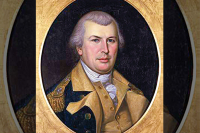WNC continues to captivate
There’s something about Haywood County.
In recent years, the small Western North Carolina community has found itself as the setting of three nationally acclaimed novels.
It started with the release of Charles Frazier’s Cold Mountain in 1997. Audiences ate up the Civil War drama, and it wasn’t long before many flocked to see the real-life setting of the fictional account. Cold Mountain maps and tours sprang up to cater to tourists near the mountain’s location in Bethel. More than 10 years later, they’re still coming.
“I’ve been told that people come to the area specifically to ask where Cold Mountain is,” says Robert Busko, director of the Haywood County Public Library system.
This past year saw the release of two more novels that are putting Haywood County and Western North Carolina on the map — both literally, and in a more literary sense. Serena, by WCU professor Ron Rash, has won rave reviews in the New York Times, New Yorker, and Washington Post. Wayne Caldwell’s Cataloochee is fast gaining in popularity and was written up in Oprah’s magazine.
If the success of Cold Mountain is any indication, these works will very likely raise the national profile of the county and the region.
Related Items
“It’s beneficial for the county — when you have writers writing about the area, people become curious,” says Margaret Osondu, owners of Osondu’s Books in downtown Waynesville. “It gives you a sense of pride.”
Rash and Caldwell’s successes, coupled with those already enjoyed by Frazier, are additionally cementing the region’s reputation as a literary hotspot.
“I would definitely have to say (it’s becoming better known),” says May Claxton, who teaches a course on Appalachian literature at Western Carolina University. “If you start to list all the authors from Asheville and over, it’s a very impressive list, and there’s still so many writers coming up with new stuff.”
A literary tradition
Though recent works have boosted the region’s profile, Western North Carolina has a literary legacy stretching back nearly a century. For example, Horace Kephart’s Our Southern Highlanders, published in 1913, is still widely regarded as a leading manuscript on life in the Southern Appalachians. And Caroline Miller, who in 1934 became the first woman to win a Pulitzer prize, lived in Waynesville.
“I do think there’s some really quality writing coming out of the area, though I’m not sure that it’s really recent,” Claxton says. “We can go back to Kephart and others, and there’s sort of a history of really good writers. There’s an interesting question about whether we’re just getting more attention paid to (the region) now.”
Osondu agrees that authors have and do abound in WNC. Exactly what it is about the region that inspires and breeds writers is something she can only speculate on.
“I think it’s because it’s so beautiful and the pace of life is slow, so you have time to be inspired,” she says.
The Appalachian tradition of storytelling could also play a part, theorizes Claxton.
“There’s such a history of storytelling and all that’s been passed down, and people realize how important that is,” she says.
A league of its own
The South is known for breeding authors, but works from WNC could stand out because Appalachian literature has its own unique qualities.
“I think there’s something very special and very interesting and a little different about the works form here,” Claxton says.
Themes in Appalachian works tend to stray from those explored in traditional Southern writing. For example, says Claxton, the conflict tends to be between those who live in the area and “outsiders” coming in to exploit it, rather than between slaves and masters.
Plus, life in the region was often tougher than in other parts of the South, and it shines through in writing.
“If you think about living here as opposed to somewhere with a more congenial climate, people were tougher here, and more prone to look for the bad and good in life,” Claxton says. “Also, I think the work ethic here was really, really strong compared to other parts of the South.”
One particular theme common in both Appalachian and Southern literature — the land and a sense of place — resonates in the works of Frazier, Rash and Caldwell.
“The land is really the central character in all of these books,” says Osondu.
A connection to the land is a theme shared in works by many Southern writers.
“I think that Southern literature comes out of a particular place and is very connected to place in a way that urban-based literature is not as connected to nature,” Claxton says.
The emphasis on place is likely a major drawing point for readers yearning for a simpler time, when people lived off the land.
“I think part of the interest could stem from the rest of the country becoming more urbanized and getting away from that connection,” Claxton says.
That’s much the same reason that people move to the area in the first place.
“All these people that move into this area are looking for more of a connection to place and the culture here,” Claxton says.
That may be why books by Frazier, Rash and Caldwell — all of which explore the culture of the area — are widely read on a local level.
“All of those books circulate really well,” says Busko. “The local people like to read them because it’s their story, and the people that move here want to acclimate and absorb as much as the local culture as they can.”









